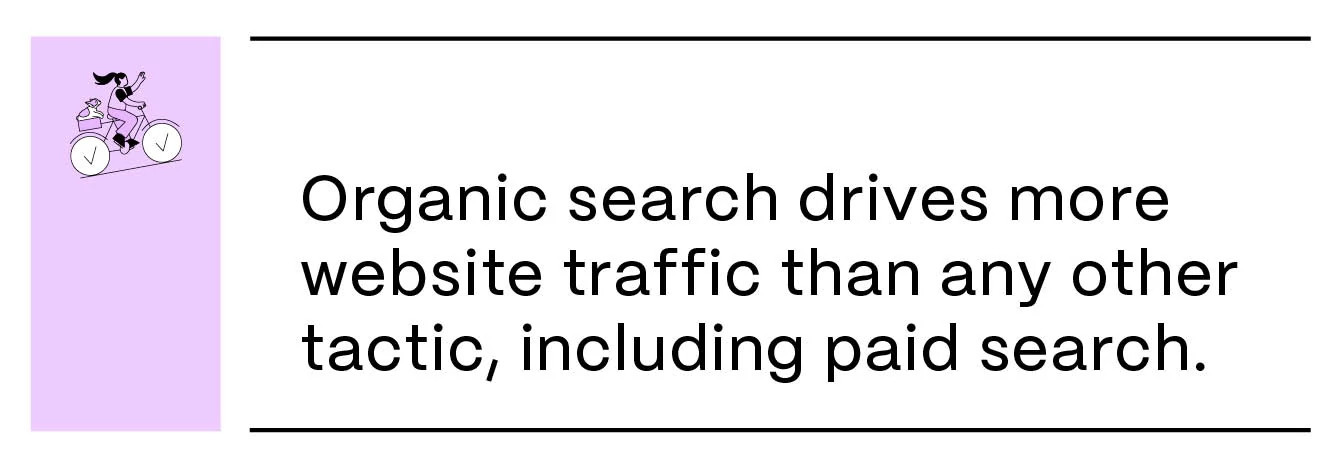
Blog
How to build a content creation workflow that works

Whether your company is looking to increase client engagement, bring in new business leads, or promote brand awareness, having the right content is essential. Setting up workflows to streamline content creation can help you reach your goals faster.
In this article, we’ll focus on how to establish content creation workflows that help your team produce high-value content faster. We’ll cover what a content workflow is, different types of workflows, valuable tools, and steps to get you started creating your own workflows.
What is a content workflow?
A content workflow is a set of pre-established steps for creating, reviewing, and delivering content. An effective workflow helps teams deliver quality work in a timely manner by ensuring that best practices are followed.
Because content is a valuable marketing tool, content workflows are important for any organization. With effective workflows, your team can efficiently produce assets that:
- Help potential customers evaluate your services
- Compare your solutions against competitors
- Increase brand awareness
- Improves your company’s reputation
- Improve SEO
Why businesses need a content creation workflow
Effective content creation workflows enable teams to meet deadlines and consistently generate high-quality content aligned with business goals.
Research shows that 51% of content consumption comes from organic search (i.e., search engines like Google, Bing, and YouTube). Organic search also drives more website traffic than any other tactic, including paid search. Businesses looking to build and grow market awareness need content creation workflows to help create more content, faster. Content creation can have a large impact on your business by increasing brand awareness, establishing your company’s reputation, and driving sales.
What happens without a documented content workflow?
Without a content creation workflow in place, your team may struggle with:
- Internal collaboration
- Meeting deadlines
- Errors getting missed
- Files being misplaced
- Understanding clear roles and responsibilities
- Following an unpredictable content production schedule
- Creating content that resonates with your audience
Fortunately, you can avoid these challenges by establishing a content creation workflow to ensure everyone understands their respective roles, expectations, and deadlines.

Types of content creation workflows: task-based vs. status-based workflows
Task-based and status-based workflows are the two main types businesses use for content creation. Because every organization has different needs for content, workflows that businesses use vary widely within these categories.
Let’s take a look at the differences, benefits, and industry-specific variations of task-based and status-based workflows.
Task-based content workflows
At each step of the process, a task-based workflow clearly establishes what needs to be done, who is responsible, and when it’s due. By breaking down content projects into clearly defined tasks and responsibilities, these workflows allow each team member to understand what they need to at any given time.
For example, if your team is putting together a blog article, you might follow a task-based workflow that looks like this:
- Content writer researches the topic of an article - Due January 5th
- Content writer creates the outline - Due January 6th
- Content manager approves the outline - Due January 7th
- Content writer writes the first draft - Due January 14th
- Content editor makes changes and suggestions - Due January 16th
- Content writer finalizes the article - Due January 21st
With a task-based workflow, each step of the process provides the details team members need to complete their respective tasks. This makes it the ideal workflow for larger teams or complex projects with multiple stakeholders. Having each task clearly defined ensures that your team won't overlook any aspect of the work.
For example, here are some task-based workflows could be used in different industries:
- Construction
Construction companies may develop content that demonstrates expertise, such as case studies, service brochures, and articles. A task-based workflow for this industry could include steps such as gathering stakeholders to decide what type of content to create, assigning staff or freelance writers, and publishing content online.
- Accounting
By establishing workflows for content creation, accounting firms can streamline the process of developing accurate and informative content for potential and current clients, as well as industry stakeholders. Some steps in a task-based content workflow for accounting might include identifying audience segments, brainstorming article ideas, writing helpful articles related to accounting topics, publishing articles online, and promoting articles on social media.
- Real estate
Real estate agencies commonly produce content to highlight properties, educate on industry trends, and promote brand awareness for potential buyers and sellers. Some steps of a task-based real estate workflow might include brainstorming ideas for content, assigning staff members or freelancers as writers, publishing content online, and promoting it to extend reach.
Status-based content workflows
Rather than denote specific tasks and responsible team members, status-based content workflows break down content projects into statuses, such as:
- Outlining
- Drafting
- Ready for review
- Revisions Needed
- Approved
- Published
Status-based workflows make it easy for team members to quickly understand how a project is progressing. For small teams or teams working on simple projects, it may not be necessary to detail what is required at each step of the content creation process. Status-based workflows can be more efficient under circumstances when in-depth direction isn’t required.
Some examples of status-based workflows from different industries include:
- Insurance
It’s important for insurance companies to develop content that educates, informs, and engages both members and industry stakeholders. A status-based insurance workflow for a regular blog cadance might include: brainstorming, scheduling posts, drafting, finalizing, and publishing online.
- Legal
Legal organizations can benefit from content that creates value for current clients, potential clients, industry peers. Some steps in a status-based legal content workflow might include defining content goals, outlining, drafting, legal review, and publishing.
5 steps to build a content management workflow that works
Setting up a content management workflow requires careful evaluation of your teams, work processes, and content needs. Here are a few steps to build out a content workflow for efficient and effective content development.
1. Establish content goals and define your audience
Depending on the audience you want to reach, your content will have different goals. For instance, different groups of potential customers will want different types of content depending where they are in the sales funnel.
Top of the funnel (TOFU) content is aimed at potential customers who have little to no familiarity with your brand. This audience group may not be looking to purchase a product right away and doesn’t want to feel like you’re trying to sell them something.
The best content to engage a TOFU audience might focus on providing education around topics related to your business rather than aggressive promotion. This means creating engaging blog articles that answer common queries or posting helpful tips on social media.
Users in the middle of the funnel (MOFU) are aware there are solutions to their challenges. At this stage, prospects are researching products and services to assess which option best meets their needs.
MOFU content should be geared toward helping prospects consider different options and why your brand might be the right fit. While this content can be brand and product specific, it should still focus on driving value for the user, which at this stage, means providing objective, straightforward information regarding your products and services.
On the other hand, customers at the bottom of the sales funnel (BOFU) are aware of your brand and others in the space. At this stage, prospects will make a purchase decision between you and your competitors.
Content for a BOFU audience should focus on providing details that help with decision-making. This may include product brochures, customer reviews, and case studies. Before getting started with content, it’s important to decide what audience you’re trying to reach and build your strategy accordingly.
2. Outline team responsibilities
After establishing goals, the next step is to determine who on your team is responsible for each part of the content creation process. Depending on the type of content you create, you may involve content writers, content editors, project managers, designers, legal reviewers, and developers.
Make sure each member of your team understands their roles, responsibilities, and deadlines. Defining who is responsible for each stage of your workflow — including who will provide final review approvals — establishes accountability. This helps to ensure work gets done correctly and on time.
3. Build a content marketing calendar
Determine how often your team will produce content. Depending on bandwidth and goals, you may produce one type of content more frequently than others. Beyond staying organized, a content calendar will make sure everything ties back to your overall content strategy.
4. Define the content creation process
Now that you’ve outlined what work needs to be done, collaborate with your team to document steps for the content creation process. These steps will vary depending on the type of content.
For example, a short blog post may require one or two rounds of revision, while a comprehensive white paper may need several rounds of review from different stakeholders before it’s complete. Make sure to plan ahead with realistic deadlines that allow each team member to do their best work.
5. Introduce automation to streamline workflows
Once you’ve established an effective content workflow, consider introducing automation to help maintain consistency.
Workflow automation software helps promote seamless efficiency by taking over routine, manual tasks such as building content templates or notifying team members when content statuses change. Software can take over disruptive manual tasks, allowing your team to focus on driving value through purpose-built content.
Many automation tools include content workflow templates that can give you a head start creating customized workflows for your team. In the next section, we’ll explore types of automation tools that can empower teams to create the best possible content creation workflows.
Related read: How to quickly find weak points in your workflow

Solve content workflow challenges with tools and templates
With pre-existing templates for common workflows, your team can quickly establish processes to help create content in record time. AI-powered tools can drive even more efficiency by automating repetitive content-creation tasks.
Here are some examples of solutions that companies can implement to build content workflows:
- Project management software: This software can use task-based or status-based workflows to help with content projects. It allows users to assign work, set deadlines, and track content statuses. It can also be used for projects outside of content creation, making it a more useful tool for the entire organization.
- File sharing and collaboration platforms: These platforms allow you to draft content directly within a secure, shared online space. A file-sharing platform simplifies collaboration across teams, making it especially useful for content creation workflows.
- Digital calendars: These tools are often free to use and can help keep track of deadlines for each step in the content creation process. While not ideal for more robust workflows, digital calendar tools can help set and manage deadlines for simple, straightforward projects and tasks.
There are many solutions and systems companies can use to help build and execute great content. Depending on the type of workflow management software you choose, your team may manage different parts of content workflows with different solutions. Teams might also choose a single solution that manages every aspect of a workflow from start to finish. The choice depends on your organization’s goals and preferences.
Set your teams up for content success
Content creation workflows maximize efficiency and streamline operations for content teams. It’s important to understand the different types of content workflows and choose one that’s right for your business.
By setting up workflows and implementing automation tools to support your team as you scale, your company can more effectively produce quality content that gets results.
Related Resources

Blog